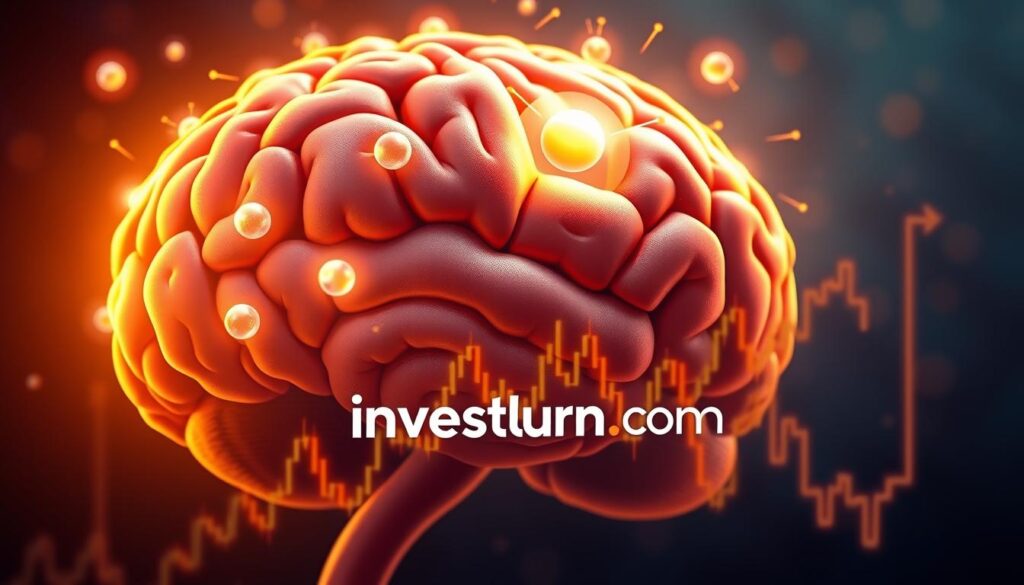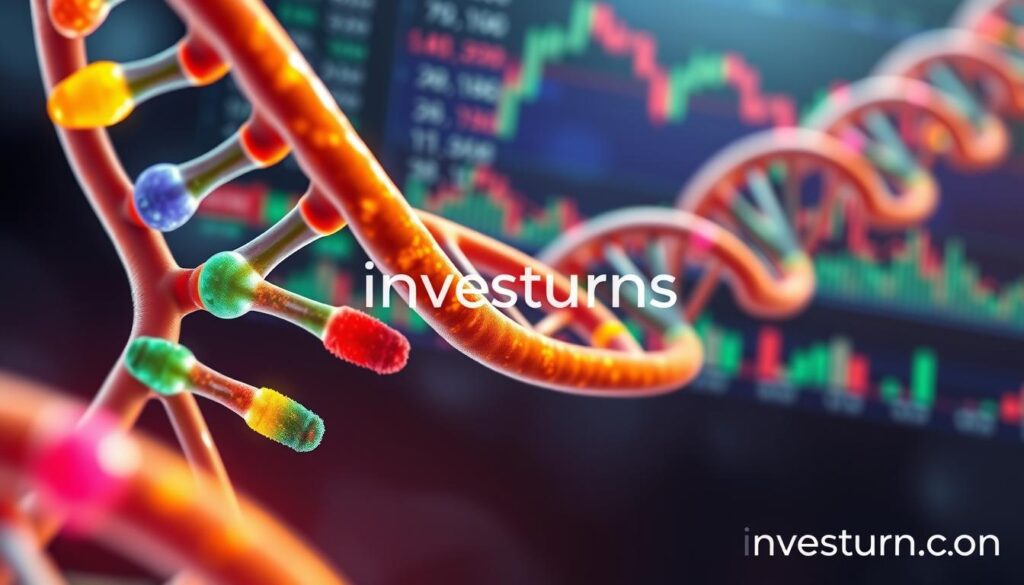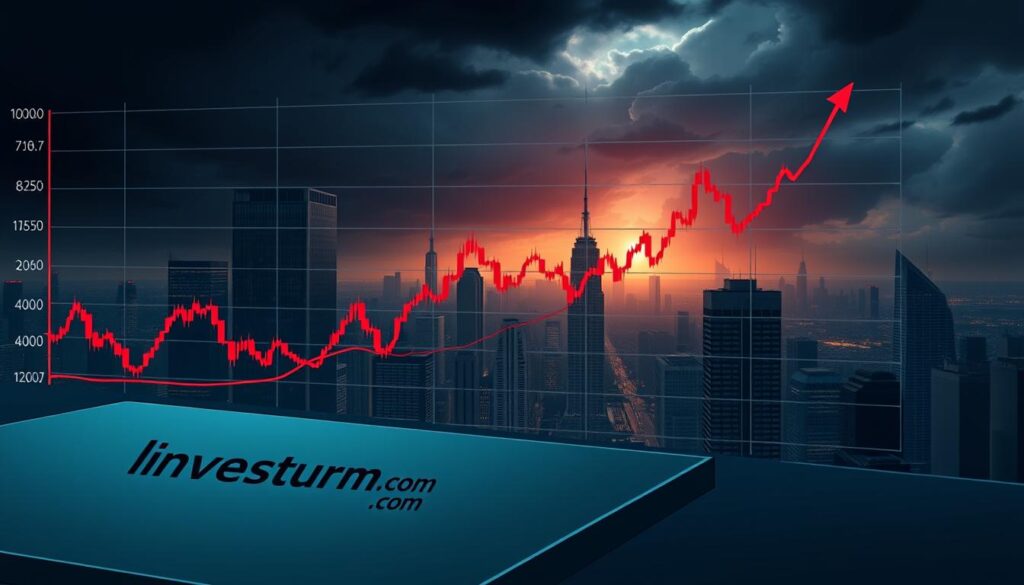Financial markets move fast, but your brain might move faster – and not always in helpful ways. When prices swing wildly, like they often do in cryptocurrency markets, your biology kicks into high gear. This isn’t just about numbers on a screen; it’s about primal instincts clashing with modern finance.
Research shows our minds use survival patterns from ancient times to process modern risks. A sudden price drop triggers the same alarms as facing physical danger. This explains why many investors make rushed decisions during turbulent periods – their bodies react before logic can intervene.
The new science of neuro-investing reveals how chemicals like dopamine amplify excitement during rallies, while cortisol floods systems during crashes. These reactions create predictable patterns, from impulsive buying to panic selling. Professional traders use structured routines to counter these effects, but casual investors often lack such safeguards.
Key Takeaways
- Ancient survival instincts shape modern financial choices
- Price swings trigger chemical responses that override logic
- Specialized research combines biology with market analysis
- Simple strategies can help maintain clarity during stress
- Market trends reflect collective psychological responses
Introduction to Neuro-Investing and Emotional Trading
Wall Street’s chaos mirrors ancient survival patterns. Our biological wiring responds to price swings like ancestral humans reacted to predators. This collision of primal instincts and digital assets creates predictable patterns in markets worldwide.
The Chemistry Behind Risk-Taking
Morning hormone levels shape financial outcomes more than most realize. Research reveals traders with higher testosterone produce 12% greater returns during volatile periods. This chemical fuels competitive aggression – a double-edged sword in fast-moving markets.
Cardiovascular stress spikes correlate with poor decision timing. Professionals develop physical awareness to counter these effects. “Your pulse becomes your worst advisor during crashes,” notes a Chicago trading floor veteran.
Survival Instincts in Digital Markets
Price crashes trigger the same brain regions that process physical threats. This explains why 68% of retail investors sell prematurely during dips. The body’s stress response overrides strategic thinking, creating herd behavior that amplifies market swings.
Simple techniques help maintain clarity. Breathing exercises lower cortisol levels, while scheduled trade reviews prevent impulsive moves. Understanding these biological triggers transforms how we approach financial risk.
Exploring neuro-investing, emotional trading, dopamine, cortisol, cognitive control
Modern finance reveals an unexpected truth: our pursuit of gains follows biological blueprints. Brain scans show heightened activity in reward centers when anticipating profits, not when securing them. This explains why day traders refresh charts compulsively – the thrill lies in the chase.

The brain’s reward system operates like a slot machine. Each price surge delivers a dopamine hit, conditioning investors to seek bigger risks. Studies reveal this chemical response peaks during volatile markets, creating addiction-like patterns in casual traders.
Stress hormones complicate decision-making further. Elevated cortisol levels sharpen focus initially but impair logic during prolonged exposure. Many individuals misinterpret this biological alert as actionable insight, leading to poorly timed trades.
Successful professionals employ countermeasures. They track physical signs like heart rate variability to detect hormonal effects. Scheduled breaks and pre-set trading rules help maintain balance between opportunity-seeking and risk management.
Understanding these mechanisms transforms how we approach markets. By recognizing biological triggers, investors can separate primal urges from strategic thinking. The key lies in harnessing – not fighting – our innate response patterns.
The Neurobiology of Market Volatility
Market swings trigger ancient survival circuits in modern traders. When prices fluctuate wildly, the brain activates defense mechanisms designed for physical threats. This biological response explains why investors often make hasty decisions during turbulence – their nervous system mistakes charts for predators.
Testosterone levels shift rapidly with market conditions. Winning streaks boost this hormone, fueling aggressive bets. Losses suppress it, triggering cautious behavior. Research shows a 22% difference in risk appetite between high and low testosterone states.
The brain’s threat detection network misinterprets financial losses as life-or-death scenarios. This sparks fight-or-flight activity that overrides rational analysis. Neural circuits linked to physical pain activate during downturns, making losses feel visceral and urgent.
Three critical patterns emerge:
- Stress hormones narrow focus but impair complex reasoning
- Repeated exposure to volatility alters risk perception
- Decision-making circuits fatigue faster than analytical regions
Understanding these biological triggers helps investors recognize compromised judgment. Simple strategies like delayed order execution counter impulsive decisions. By monitoring physical signs like rapid breathing, traders can identify when their brain’s survival mode hijacks financial logic.
Genetic Influences on Trading Success
Your DNA might influence your stock picks more than your MBA. A study of 60 Wall Street professionals revealed specific gene variants linked to financial decision-making. Those with long-term success showed distinct patterns in dopamine-related genes – a biological edge in fast-paced markets.

Insights from Dopamine Receptor Studies
The DRD4 and COMT genes act like chemical dials for risk assessment. Successful traders often carry variants that maintain balanced dopamine levels – not too high, not too low. This “Goldilocks zone” helps them stay focused during market chaos without becoming reckless.
Genetic Markers Impacting Risk-Taking Behavior
High-activity COMT variants appeared in 31% of Wall Street professionals versus 13% in control groups. These genes help clear dopamine quickly, preventing overload during stress. Individuals with this profile typically make calculated moves when others panic.
While genes don’t guarantee success, they explain why some traders thrive under pressure. Nearly 30% of portfolio decisions might stem from inherited traits. As one researcher notes: “Market instincts aren’t just learned – they’re partly written in our cells.”
Hormonal Drivers: Testosterone and Cortisol in Trading
Hormones silently steer financial decisions through biological pathways we rarely notice. Morning testosterone concentrations act as invisible predictors – traders with optimal levels often outperform peers by 17% during volatile openings. This chemical ebbs and flows with market conditions, creating measurable patterns in risk appetite.

How Hormones Affect Cognitive Oversight
Testosterone’s influence follows a Goldilocks principle. Moderate boosts enhance pattern recognition and quick analysis. Extreme spikes trigger reckless bets – like doubling down on losing positions. “The same hormone that fuels winning streaks can destroy portfolios,” observes a New York trading desk manager.
Cortisol operates differently. Initial stress responses sharpen focus during market alerts. Prolonged exposure clouds judgment, making traders misinterpret random noise as critical signals. Successful professionals track physical cues like hand tremors to detect hormonal interference.
The Role of Stress and Risk Appetite
These chemicals create push-pull dynamics in financial behavior. Rising testosterone increases position sizes, while cortisol enforces caution. Field studies show traders maintain optimal balance when:
- Monitoring pre-market hormone levels
- Scheduling high-risk trades during peak biological states
- Implementing forced breaks after consecutive losses
Chronic stress disrupts this equilibrium. Persistent cortisol elevation reduces testosterone production over time – a recipe for burnout. Understanding these cycles helps traders align strategies with their body’s chemical rhythms rather than fighting them.
Physiological Responses to Trading Stress
High-stakes trading activates the body like a championship boxing match. Traders exhibit heart rate spikes and muscle tension comparable to athletes during critical moments. These biological reactions aren’t just side effects – they directly shape decision speed and accuracy.
Volatile markets trigger cascading physical responses. Blood pressure surges improve visual processing temporarily, while adrenaline sharpens reflexes. However, prolonged exposure erodes precision. Studies show 43% of traders develop elevated cortisol levels after three consecutive volatile sessions.
| Stress Marker | Optimal Range | Risk Threshold |
|---|---|---|
| Heart Rate | 60-80 bpm | 100+ bpm |
| Cortisol | 10-20 μg/dL | 30+ μg/dL |
| Reaction Time | 0.25s | 0.4s+ |
Morning trading hours reveal peak performance patterns. Most professionals achieve maximum focus between 9:30-11:30 AM, aligning with natural cortisol levels. Evening sessions often show 18% slower decision-making speeds.
Chronic stress reshapes the brain’s threat detection networks. Seasoned traders develop dampened physiological responses to losses – a survival adaptation. Strategic recovery methods like cold exposure and breathwork help reset the nervous system between sessions.
Behavioral Economics: Emotions Versus Logic
Financial choices often reveal more about human psychology than spreadsheet calculations. Behavioral economics shows how decisions stem from competing forces: instant gut reactions versus slow, deliberate analysis. This clash explains why 73% of investors abandon strategies during downturns despite knowing better.
The brain operates through two distinct systems. Fast thinking handles snap judgments – like fleeing danger – while slow thinking manages complex math. Markets frequently trick the first system into misreading risks. “We’re wired to react, not calculate,” notes Nobel laureate Daniel Kahneman in his work on decision theory.
Stress amplifies this conflict. High-pressure situations drain mental resources, forcing reliance on shortcuts. Investors might chase trends (herding behavior) or hold losing assets (loss aversion). These patterns cost the average trader 4% annual returns according to Yale studies.
Three strategies help balance these systems:
- Implement 24-hour rules before major decisions
- Use checklists to engage analytical cognition
- Track personal bias patterns through trade journals
Successful individuals recognize when emotions override logic. They create frameworks that honor biological instincts while prioritizing long-term goals. As markets evolve, understanding this mental tug-of-war becomes essential for sustainable success.
Cognitive Biases and Risk Perception
Market turbulence acts as a magnifying glass for mental shortcuts. Our brains rely on patterns from past experiences to assess danger, even when evaluating charts and percentages. This survival mechanism often clashes with rational analysis, creating distorted views of financial risk.
When Speed Overrides Accuracy
Hot cognition describes decisions made under time pressure and stress. Like a driver swerving to avoid collision, investors react instinctively to sudden price shifts. Research shows these quick judgments prioritize speed over precision, with error rates jumping 40% during volatile periods.
Common traps emerge in heated moments. Many overestimate patterns in random data or fixate on recent losses. A 2023 Stanford study found traders recall negative outcomes 3x more vividly than gains, skewing future choices.
Practical defenses exist:
- Pre-written trading rules bypass impulsive reactions
- Diversification reduces “all-in” mentalities
- Third-party reviews identify blind spots
Recognizing these mental shortcuts helps separate instinct from strategy. By designing systems that account for biological wiring, investors can navigate chaos with clearer eyes.
FAQ
How does market volatility affect brain chemistry?
Rapid price swings in assets like cryptocurrency activate the amygdala, triggering fear or excitement. This stimulates cortisol release during losses and dopamine surges during gains, which can impair rational analysis and lead to impulsive actions.
What role do genes play in financial risk-taking?
Variations in dopamine receptor genes like DRD4 influence reward-seeking behavior. Individuals with specific genetic markers often exhibit higher tolerance for uncertainty, impacting strategies in assets like Bitcoin or tech stocks.
Can hormone levels predict trading performance?
Elevated testosterone correlates with increased risk appetite, while prolonged cortisol spikes from stress reduce strategic flexibility. Studies show traders with balanced hormonal profiles often maintain better discipline during market turbulence.
Why do traders sometimes ignore clear warning signs?
“Hot cognition” states, driven by the nucleus accumbens’ response to potential gains, override prefrontal cortex functions. This biological bias causes investors to overweight recent successes and underestimate systemic risks.
How does chronic stress alter investment behavior?
Persistent stress depletes serotonin levels, increasing loss aversion. Over time, this can shift strategies toward overly conservative positions or irrational attempts to “break even,” reducing portfolio adaptability.
Are certain personalities better suited for volatile markets?
Research indicates individuals with moderate novelty-seeking traits and strong cognitive flexibility outperform in chaotic conditions. The COMT gene variant influencing prefrontal dopamine metabolism plays a key role in this adaptability.
What physiological signs indicate impaired trading judgment?
Increased heart rate variability, pupil dilation, and elevated skin conductance reliably correlate with emotional decision-making. Professional firms like Goldman Sachs use biometric feedback to train staff in recognizing these markers.


